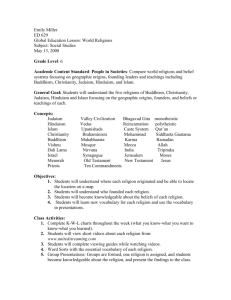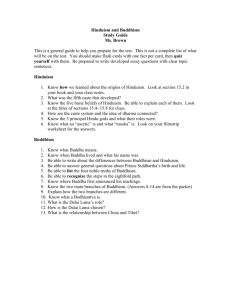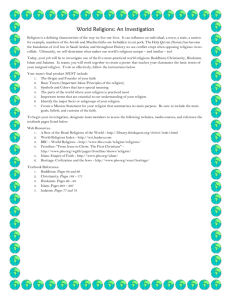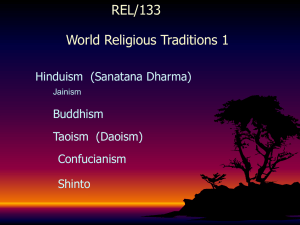ABOUT BUDDHISM AND ANIMISM
advertisement
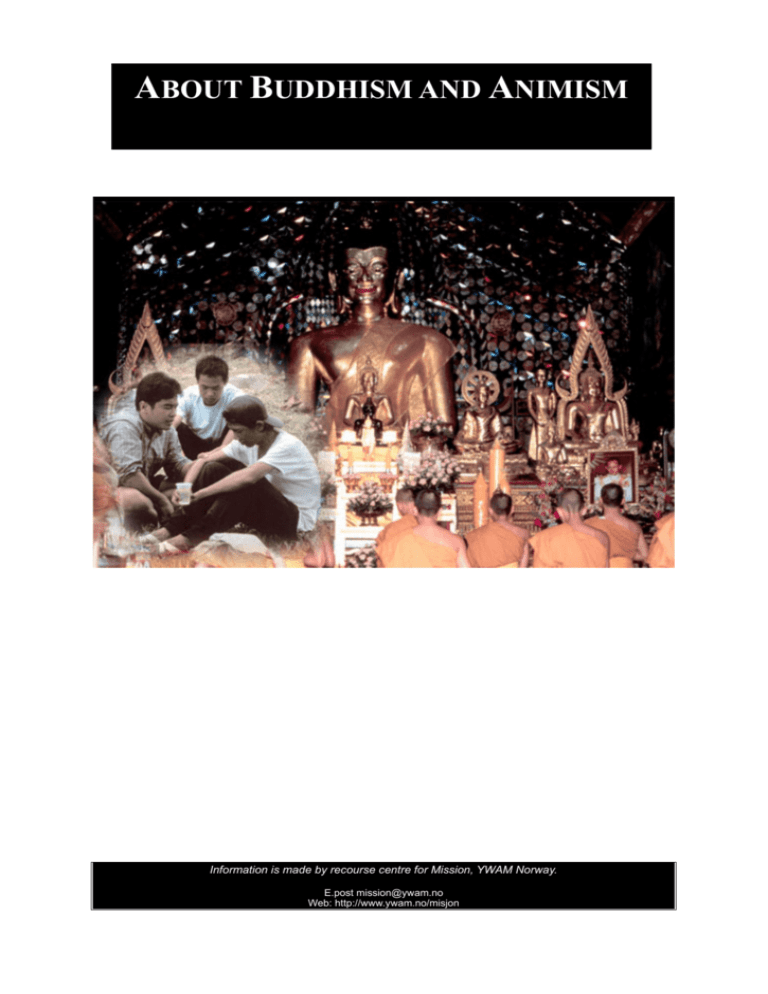
ABOUT BUDDHISM AND ANIMISM Information is made by recourse centre for Mission, YWAM Norway. E.post mission@ywam.no Web: http://www.ywam.no/misjon Religions In East Asia In south East Asia are Buddhism one of the main religions; often you find it mixed with Animism. Some of this information is collected here. The key to reach them with the Gospel I believe we can find keys to reach them with the gospel by getting some knowledge about their religion. But you also need to know something about their worldview, to understand that they have a total different worldview then us coming from the west. When you wish to reach a Buddhist with the gospel you should not start with Jesus. Because they have no clue who He is and also what grace means. Genesis is actually the book that you should start with. Explain everything from the beginning. Its also important to not use Christian jargons when you talk to them. Buddhism History and origins Buddhism was founded in the sixth century BC, by Siddhartha Gautama, later known as the Buddha (the Enlightened One). He was born in former north-eastern India (now Nepal) around 560 BC. At this time Hinduism had been in India for 1000 years, introduced by Aryan tribes whose cultures had influenced the whole subcontinent. The son of a rajah, Gautama had a wealthy upbringing. According to tradition, his father had been given a prophecy: Gautama would either be a great ruler or a homeless wanderer. In Om Øst Asiatisk kultur Side - 2 - order to prevent the second from happening, his father sheltered him from all influences outside the palace. He was well educated and privileged. But Guatama left the palace one day and saw four kinds of suffering. He became dissatisfied and left his family to discover the source of suffering and the way to eliminate it. He first tried to search for knowledge through traditional Hindu methods (eg yoga). Then he travelled to northern India and for six years lived an extremely ascetic life. Realising that asceticism did not bring freedom from suffering, he turned to meditation. At a city called Bodh Gaya, he sat under a fig tree resolving not to leave until he had attained enlightenment (the highest knowledge). After some time he reached enlightenment and became the Buddha. Enlightenment had three stages: first, he saw his previous lives pass before him; second, he saw the cycle of birth, death and rebirth and the law which governs the cycle (reincarnation); third, the four holy truths were revealed to him: the knowledge of suffering, the source of suffering, the removal of suffering and the way to the removal of suffering. Despite doubts that people were ready for new teaching, Buddha began preaching and gathering followers. He called his path to enlightenment the Middle Way, because it avoided the extremes of affluence and asceticism. Buddhism grew out of the Hindu world. Gautama struggled with questions of wealth and suffering, and sought to find freedom and truth. Hence Buddhism inherited some Hindu ideas (eg reincarnation, karma) and rejected others. Many teachings and ideas were later absorbed which were not part of Buddha’s original teaching. Some of these teachings are based on Hindu traditions. Buddhism spread into many parts of east, south east and central Asia, to be superseded by Islam in some areas. Beliefs The four noble truths • The first: suffering is the basic human condition—the mental, emotional and physical suffering we endure is a result of past karma. • The second: the cause of our suffering is our desire for transient things. We value people and material things too highly, but ultimately cannot depend upon them. • The third: suffering can be eliminated—if we stop desiring the temporary. • The fourth: the way to eliminate our desire is to follow the eight-fold path. The eight-fold path Wisdom/insight • Right knowledge or understanding • Right attitude/thought Ethical conduct/morality • Right speech • Right action Om Øst Asiatisk kultur Side - 3 - • Right way of living Mental discipline • Right effort • Right awareness • Right composure/ meditation Keeping to the eight-fold path is difficult and requires determination and commitment. Nirvana: the goal Nirvana is not a Buddhist ‘heaven’, nor self-annihilation. It is the end of suffering. The word nirvana is derived from a verb meaning ‘to waft away.’ Buddha described nirvana as unlike the earth or anything of the earth, nor like consciousness, nothingness, the sun or the moon. It is sometimes called a transformed consciousness, but is not like the Christian idea of the soul, as Buddha did not believe that the inner person existed. Nirvana can be partially experienced before death, through meditation. Personality and the soul In western thought, personality is a consistent unit determining the behaviour and choices of a human being. Buddhism views the human as part of the universe, an arrangement of elements which are always changing. The soul, self or individual does not exist as such. Reincarnation As the universe constantly changes and decays, human beings also change, decay and reform. Karma Karma is the moral law of cause and effect. We reap what we sow, in the present life and afterwards. We are bound by the consequences of karma. Types of Buddhism Theravada teaching of the ancients A division within Buddhism occurred around the beginning of the third century BC, primarily over the issue of enlightenment. Followers split into two traditions: Theravada and Mahayana. Theravadins believe that enlightenment is only accessible by a few true believers. The individual moves toward enlightenment alone, with no help from rituals or even statues of Buddha, since Buddha and others who have died are believed to have entered nirvana. Theravada is the tradition which most closely follows Buddha’s teaching. It spread from India into south east Asia. Mahayana the greater vehicle Om Øst Asiatisk kultur Side - 4 - Mahayana is the ‘greater vehicle’ because there is room within it for all—salvation or enlightenment is for all people. Followers of Mahayana refer to the earliest Buddhist writings used by Theravadins, but also use many other writings. Vajrayana the diamond vehicle Vajrayana is similar to Mahayana, but also includes mystical and occultic elements from Tantrism, an ancient Indian tradition. The name derives from vajra, meaning something bright, transparent, indestructible, like a diamond, and referring to the purity of tantric spiritual power. Vajrayana uses mantra (chant), mudra (physical gesture) and mandala (meditation circle). It began in India in the first century AD, then spread to Nepal, Tibet, China and Japan. Lamaism Lamaism is the form of Buddhism widely followed in Tibet. Lama was originally a word applied to a high spiritual leader but later came to mean a monk. Lamaistic Buddhism developed at the end of the seventh century AD, as a blend of Vajrayana and the ancient Tibetan Bon religion. The Dalai Lama (‘lama great as the ocean’) is the wordly leader while the Panchen Lama (‘jewel of the scholars’) is the spiritual leader. Zen Zen Buddhism is popular and influential in Japan. Originally based on Mahayana, it was known as Ch’an and was introduced to China in the 6th century AD, from where it spread into Japan in the 12th century. Little importance is placed on concern with teaching, and greater importance on meditation, through which one is believed to reach enlightenment. Zen has left its mark on Japanese society, culture and customs. Folk Buddhism This is the dominant form of Buddhism in many parts of East Asia, particularly rural areas. Elements of Buddhism are mixed with local religions, usually animistic. This produces a spirit-based world-view and lifestyle based around rituals and superstition. In some areas there are beliefs in other deity figures such as Buddha’s mother, with temples dedicated to them. Folk Buddhists are often not aware of the difference between their beliefs and the dominant Buddhist traditions. Other points • • • • Buddhists generally believe that there are many paths to one God. Buddhism denies that we have a soul or personality, so a personal understanding of God is an alien idea. Buddhists in East Asia will largely follow a mixture of one or more dominant Buddhist traditions, animism and ancestor worship. Jesus is understood to be a spiritual master similar to Buddha. Om Øst Asiatisk kultur Side - 5 - • Most Buddhists have either not heard the gospel or have not understood it. Pray for • • • • Christian witness in countries with limited religious freedom—China, Laos, Myanmar. Christians in Buddhist regions. Tibetan Christians outside Tibet—unable to return and share the gospel because of political instability. The impact of Christian radio programs and stations broadcasting in Buddhist areas. Buddhists who may be questioning their beliefs or feeling disillusioned. Stories are told of dreams, visions and prophecies which have occurred in isolated or ‘closed’ areas, preparing people for Christian witness. Om Øst Asiatisk kultur Side - 6 - Animism Definition The word ‘animism’ derives from the Latin word anima, meaning soul or breath. It is usually applied to any religious beliefs, which recognize spirits or a spirit world inherent and controlling within the physical world. Distribution primal religions. Primal religions are before the advent of world religions Hinduism. There are many such rural or undeveloped areas, island minority nationalities. Animism is religions in East Asia, in the form of folk religion. Animism can be found in many tribal or those which are ancient, in existence such as Christianity, Buddhism, religions in East Asia, particularly in communities and among tribal groups or also found within most of the world Context Many people following primal religions live in isolated rural areas. Their lives are built around the forces of nature. Birth, death, illness and disaster are not hidden or sanitised as they are in many developed societies. Outside forces such as foreigners or neighbouring peoples may be feared. Some tribal groups are nomadic. It is easier to be aware of a spiritual dimension to life, and when human strengths and frailties are exposed by such environments, there is a need for spiritual support. Primal animistic religions share essential similarities with world religions: a belief in a powerful spiritual realm which coexists with the physical world; usually prayer, sacrifice or offering as a means to communicate with the spiritual world; shrines, temples or sacred places; priests, shamans or mediums who can help the people to hear from the spirits or gods, and sometimes a belief in a ‘sky god’ who is creator and above all other gods/spirits. Om Øst Asiatisk kultur Side - 7 - Animistic folk religions usually grow out of primal religions mixed with one or more world religions. This happens when a world religion is introduced to the area where animistic religions are already practised. The world religion may seem to predominate, but often its tenets and practices will be less important than, or followed alongside, folk customs based on spirit belief. Beliefs and practices The spiritual force and the spirit world The basis of animism is that the spirit world is stronger than humans. The power of the spirit world infuses everything. Spirits are often believed to dwell in particular objects, such as a tree, or places, such as an area of forest, or a village. Sometimes the spirits move around, even following people if they move. Origin of the spirits Some spirits are the souls of deceased ancestors. Others are beings inherent in nature and the spirit realm. For some people the spirits are intermediaries between humans and a higher god. This is often the case in a folk religion, or a primal religion recognising a supreme god. In other primal religions, the spirits are the primary beings of the spirit realm. As such their help is sought. Sometimes the help of particular spirits is sought for particular occasions, eg during illness or war, for marriage or childbirth, or for work and study. Help is also sought for amelioration of weather conditions or a good harvest. Relationship with the spirits Relationship between the spirit world and the human world is ongoing and requires human effort. Some spirits are seen as friendly and helpful, and gratitude is shown by the human effort of prayer or offerings. Other spirits may be evil or troublesome, and need to be avoided or appeased. Human effort is required to ensure the goodwill of the spirits, and to ensure that they are not offended or neglected. Contact with the spirits For contact with the spirits special methods and/or trained, gifted individuals are usually required. Some tribal groups have a shaman. Shamans enter the spirit world by way of an ecstatic trance. They return to the earthly world with messages from the spirits. Other communities make contact through a medium or through divination. Methods of divination include astrology (eg in China), fortune telling (eg by selection of a written ‘fortune’ in folk Buddhism) and rituals (in many tribal communities). In many areas, including those where a world religion is established, there are local healers who prescribe rituals to seek healing from the spirits. In rural areas they will also use natural methods (plants and herbs). Case studies Om Øst Asiatisk kultur Side - 8 - The Karen people of north Thailand ‘Animists believe everything is animated by spirits. The Karen believe spirits live in houses, fields, water, rice, buffalo, and trees. They all must be given sacrifices of food and kept happy lest they become angry and cause calamity to fall on the people. Often we saw offerings to spirits put out along the paths with bits of tobacco, thread and betel nut placed on a piece of old cloth. Besides spirits, Karen believe in taboos that cause calamities when broken, and curses that will kill other people… ‘Karen believe they have 33 souls—one for various parts of the body with the main one behind the ear. These must all be appeased with an offering and tied in with strings around the wrists. If one of these souls leaves, the person becomes sick and must make another sacrifice to call back his soul. If someone dreams, his soul is actually doing the things he dreams about. If someone wakes him up from a deep sleep too quickly, the souls may not have had a chance to get back to the body in time, so they must be called back and tied in.’ —from Stronger than the Strong by Louise Morris (OMF Books 1998) The Naxi people of south west China The Naxi live mostly in Yunnan and Sichuan provinces. They have a long history and traditionally are a matriarchal society. There is no traditional marriage; in the past, no-one left the family home, and children were brought up by their mother, taking her surname. There is no word for ‘father’ in the Naxi language. Their rich culture has been heavily influenced by the Dongba religion. Dongba is polytheistic, animistic and contains elements of Taoism and Buddhism. The Naxi believe that all forces of nature contain spirits. They also venerate ancestors and try to make contact with ancestors in the spirit realm. Their gods include Sanduo, a ‘protection god’ and Yama, a feared ‘death god’. There are over 20,000 Dongba scriptures, recorded in hieroglyphs. The Naxi creation myth recorded in the scriptures tells that their ancestor, Tabu, helped them to hatch from magic eggs. The religious leaders are shamans. They perform rituals, contact spirits and are usually healers, artists and scholars. Comparisons Similarities shared by animistic primal religions and Christianity: • Closeness to nature • Recognition of human frailty • Understanding of human need for a stronger power • Awareness of the spiritual realm • Life after death Contrasts Elements of animistic primal religions not shared by Christianity: • Many gods or spirits • Often no scriptures • Some use magic as well as religious practice Om Øst Asiatisk kultur Side - 9 - • • • • The sky god is not close to his people and does not lead by moral example or rule Relationships are restored by sacrifice and appeasement, rather than repentance and forgiveness Some spirits are volatile and capricious Spirits are local rather than universal Other points • • • • • Many people in East Asia may belong to a major religion such as Islam but actually follow a mixture of that religion and animism Tribal animism is part of a deeply religious way of life in which the spiritual and physical are inextricably linked. Animistic religions often involve a strong element of fear. Christianity often seems to fail beside animism because it does not seem to ‘work’ as effectively in terms of healing. Many people are content within animistic religions and their ancient beliefs are integral to their culture. Pray for • • • • • Missionary work in purely animist areas; some tribal peoples have accepted the gospel quickly, with a sense of the fulfilment of an ancient expectation; others are very resistant. Sensitivity in evangelism, particularly when culture and religion are deeply interrelated. Mongolia: 50 percent of the population follow shamanism or animism. China and Thailand: many of the minority nationalities are animist. Animistic people to accept the true God without losing their cultural identity. Om Øst Asiatisk kultur Side - 10 - Source Informasjon abut buddhism and animism is from and copyright © OMF. Se også deres websider http://www.omf.org Other: Resurssenter for Ungdom i Oppdrag. Copyright © Ungdom i Oppdrag Websider http://www.ywam.no/misjon Om Øst Asiatisk kultur Side - 11 -

